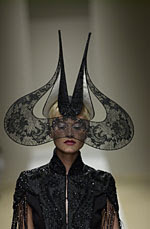
David Downton's illustrations from 1999 to 2007
from left top to right bottom...
in 1999, he mainly used water color on paper and he also used with pastel, ink or pencil.
in 2000, ink is mainly used in his drawing and gouache also used for drawing on paper. and he also started to use acetate overlay. he used water color and pastel.
in 2007, he used water color and ink with charcoal.
some interview information about details in his works
Lets talk about your work methods. How do you arrive at the elimination of detail?
For me this is the hardest and the most interesting thing. In order to leave something out, first you have to put it in, or at least understand how every thing works. I do dozens of drawings on to layout paper taking the best from each one as I go. When the drawing looks right I start to eliminate, to de-construct if you like. I keep working until it looks spontaneous.
What methods do you use to apply colour?
It depends on the result I want to achieve and what is most appropriate to the subject. I use watercolour or gouache for small scale pieces. If I need flat saturated colour I use cut paper collage and then apply line using an acetate overlay.
What about the pure line drawing?
I use black Indian ink on acetate or paper.





















































